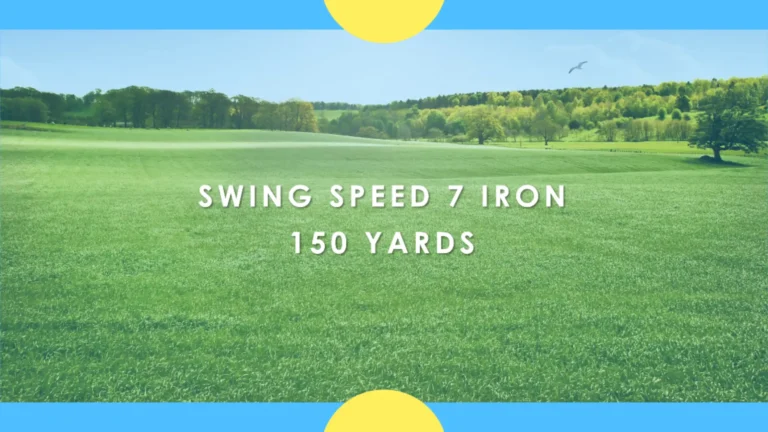What is the Average Golf Swing Speed for a 65 Year Old Man?
Golf swing speed typically declines with age, but many 65-year-old men can still generate impressive clubhead velocities. The average speed for this age group is around 90 miles per hour (mph), though healthier and more athletic players may reach 100 mph.
Understanding the factors that influence speed, as well as how to increase it through training and technique adjustments, can help senior golfers hit the ball farther and shoot lower scores.
What Determines Swing Speed?
Average golf swing speed is the rate of clubhead travel at impact, measured in mph or feet per second. Faster swing speeds typically result in longer drives, whereas slower swings limit shot distance and height.
TrackMan and other advanced launch monitors provide exact numbers, but most recreational players make estimates based on driving distances. Those carrying drives of 250 yards or more are likely to swing at speeds greater than 100 mph. Anything under 200 yards indicates a very slow swing of less than 80 mph.
Effect of Age on Speed
It is no secret that swing speed decreases with age. In his prime, a tour professional could average 115-125 mph, whereas seniors struggle to reach 100 mph. The loss is closely related to muscular strength and flexibility. Fast swings generate approximately 2,000 pounds of force while violently torquing the body.
Older muscles are unable to contract as quickly or powerfully during such movements. Seniors are also unable to maximize their speed due to their limited turn and stability. However, staying fit and strong can significantly reduce the effects of aging.
Average Speed for a 65-year-old
Most 65-year-old golfers average 80-100 mph. TrackMan data shows that the exact average golf swing speed is 93 mph. This is consistent with expected driving distances of 200-250 yards for the age group. Again, maintaining athleticism and incorporating specific speed training into your golf fitness regimen allows for higher speeds.
Some exceptional players can still break 100 mph in their late 60s. Alignment, angle of attack, spin rate, and other ball-striking factors all influence distance. But clubhead speed is the foundation for powerful golf shots.
Influences on Speed Capabilities
Fast swing speeds are made possible by a combination of physical and technical factors. Golfers over the age of 65 should consider the following key areas:
Strength & Power
Building muscular power through resistance training and plyometrics provides the force required for speed. Concentrate primarily on the core, hips, legs, and upper back, which generate force and stabilize motion.
Flexibility and Mobility
The modern golf swing requires a wide arc and coil, as well as adequate torso rotation. Stiff or frozen joints significantly reduce speed. Regularly stretch your hips, torso, and shoulders.
Weight Transfer
Changing pressure between feet during the swing increases clubhead velocity. Transfers are made more efficient thanks to strength, balance, and coordination.
Leverage
Proper wrist hinging, arm positioning, posture, and axis tilts provide leverage for amplifying force. Optimize angles to increase speed and control.
Timing and Sequence
Perfect timing throughout the kinetic chain enables each body part to contribute to speed. The sequence adds momentum rather than detracting from it.
Technique and Efficiency
An efficient swing takes the optimal geometric path for clubhead speed. Excessive motion, manipulation, poor contact, and off-plane delivery deplete momentum.
Cardiovascular Endurance
The ability to maintain high intensities throughout a round without tiring improves speed. Increase stamina with steady-state and interval cardio training.
As we progress through the article, keep in mind that many physical limitations are closely related to age. However, you can still make significant progress by training intelligently and working within your abilities.
Speed Differences Among Drivers and Other Clubs
The driver provides the fastest clubhead speeds due to its length, mass distribution, ball position, and swing mechanics. The average 65-year-old man swings a driver at approximately 93 mph. However, fairway woods typically measure 5-10 mph slower.
Speed decreases again with shorter irons. Because of degressive weighting, an 8-iron may swing 20 mph slower than a driver. However, increased precision through the set allows for greater control when hitting different distances.
Senior golfers are generally unconcerned about speed when using scoring clubs. Making solid contact for an adequate distance is the priority here. However, maximizing driver velocity while keeping it in play offers a significant advantage. Adding just 5 mph results in 10+ yards, which means more birdie opportunities.
Swing speed declines over time.
Through the age of 60, we can expect our average golf swing speed to drop by about 1.25 mph per year. The decline accelerates after 65. Physical capacity begins to decline faster, and swing repetitions decrease as playing frequency decreases.
This accelerates the decline of mobility, strength, and motor control. Junior and professional golfers gain speed in their mid-20s, peaking between 29 and 31 years old. However, expect decreases from the early 30s onward.
By age 70, the average male swing speed has settled at 85 mph, with many slower than 80. Extreme seniors and those suffering from illness or injury may struggle to reach 70 mph. At this point, strength and flexibility exercises are required to maintain functional golf mobility at all speeds. However, committed senior golfers can still make small speed gains while staying within their physical limits.
Improving Swing Speed After 65
The key to increasing clubhead speed after 65 is to train the appropriate physical qualities while instilling proper swing technique. Follow these guidelines to gain yards with faster swing speed:
Monitor Speed
First, use a launch monitor or estimate the clubhead speed based on driving distance. This provides a starting point for tracking progress. A carry distance of 250 yards equates to a speed of approximately 100 mph.
Get Fit for Power!
Engage in a power-focused resistance program that targets the hips, torso, and arms. Squats, deadlifts, presses, pulls, and medicine ball exercises help to build golf-specific strength. Include plyometric exercises as well.
Increase flexibility
Stretch the hip flexors, chest muscles, and shoulders to loosen up tight areas. Regularly foam roll and use a lacrosse or therapy ball to break up adhesions. Yoga and assisted stretches are also beneficial for flexibility.
Refine Motion Patterns
Ingrained swing flaws detract from speed more than strength and mobility issues. Lessons, video analysis, impact drills, and slow practice help identify inefficient movement patterns.
Maximize leverage
Set the proper wrist cock, posture, axis tilt, and arm swing to maximize your power output. Changes made here result in immediate speed gains before strengthening the force generator.
Improve transfer
Smooth weight shifts during the swing promote efficient motion patterns. Feel the rear and front pressure points by practicing with different foot alignments.
Maintain a quick tempo
A faster transition tempo maximizes momentum and keeps the club accelerating into impact. Avoid displaying deceleration warnings on launch monitors.
Consider equipment
Custom club fitting enables senior golfers to optimize shaft load, launch conditions, and spin rates for maximum distance. Drivers now offer adjustable features for swing speeds under 100 mph.
Prevent injuries
When pushing physical limits, avoid overworking joints and connective tissues. This may necessitate changing the volume, intensity, and rest periods while training.
Staying realistic about age-based swing speed expectations avoids frustration. However, a focused training program allows for continuous, gradual improvement until your late 60s. To achieve the best results, combine physical conditioning with optimal technique.
Expected Yardages by Swing Speed
In general, clubhead speed and driving distance are highly correlated. Most golfers over the age of 65 average 80-100 mph and 200-250 yards per shot. However, faster swingers can still reach 250-300 yards or more. Use this chart to estimate distances based on your swing speed.
At 60 mph, the distance is approximately 165 yards. At 70 mph, it is approximately 190 yards. At 80 mph, it is approximately 210 yards. At 90 mph, it is approximately 230 yards long.
100 mph equals approximately 250 yards
110 mph equals about 270 yards, while 120 mph equals around 290 yards.
Of course, angle of attack, club path, strike location, and spin rate all have a significant impact on distance. However, the numbers above represent reasonable expectations for solid strikes under typical launch conditions. Improving swing speed is especially important for seniors who struggle off the tee and keep the ball in play.
Conclusion
The average golf swing speed for a 65-year-old man is 90-95 mph. This is consistent with the driving distances of 220-240 yards expected of better senior players.
While speed potential declines with age due to muscle deterioration, proper physical training and swing adjustments allow for continuous improvement until your late 60s. Lower handicap players can maintain speeds of more than 100 mph by following a focused regimen that combines strength, flexibility, tempo, technique, and equipment fitting.
At any fitness level, track your progress against a baseline while developing power, mobility, and efficient mechanics to maximize clubhead velocity. Maintaining a fast swing speed leads to longer drives and more birdie opportunities.







